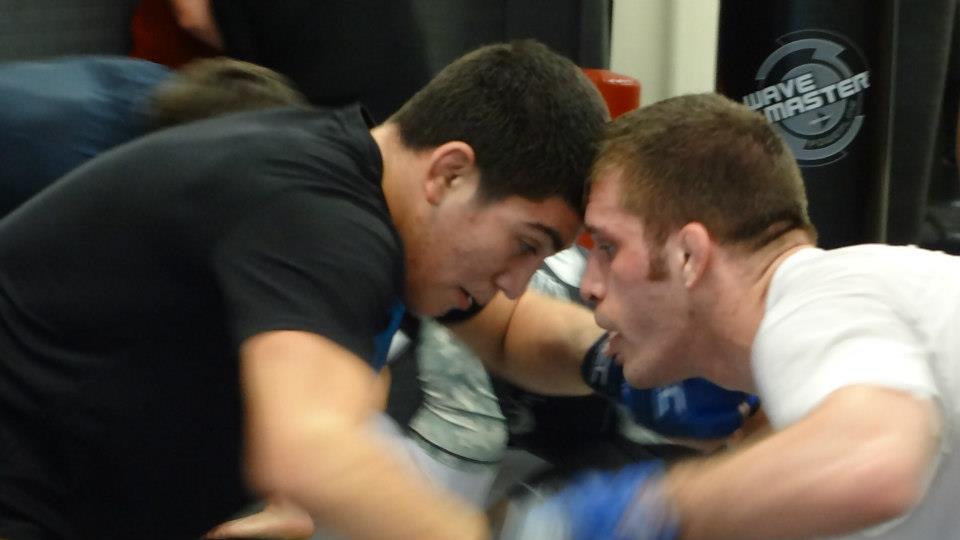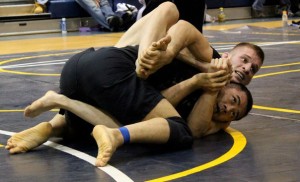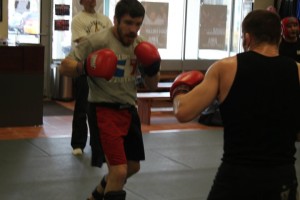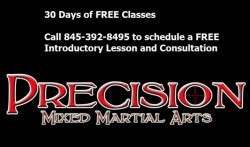The 33% Rule
Hudson Valley Training tactics from Brian McLaughlin head Hudson Valley MMA coach at Precision Mixed Martial Arts in LaGrange, NY
Over the last decade I’ve trained at just about every major MMA gym on the east coast from the Hudson Valley to South Florida. I’ve been an instructor, sparring partner or student of fighters ranging from UFC world champions to first time amateurs – I’ve even seen guys go from their first fight in empty middle school gymnasiums to fighting for 6 figures in front of sold out Las Vegas crowds. In this time I’ve seen a myriad of different training approaches and practice routines all with varying levels of effectiveness. Some gyms focused mainly on striking, others were wrestling based and many had a jiu-jitsu approach – but what I’m going to talk about here transcends styles and techniques. This is the training approach that I believe allows an athlete to put themselves in the best position to be successful – the 33% rule.
The old mantra repeated by just about every guru in the business is “train smarter not harder” but what does that really mean? In my estimation this statement highlights the fact that hard work and effort, at a certain point, yield diminishing returns. Biting down on your mouthpiece and pushing yourself 100% certainly has its place in combat sports, but in order to reach the upper echelons of the sport most agree that a higher level of sophistication is warranted. Therefore, training smarter would be defined as the approach which most efficiently leads an athlete towards improvement without injury or burnout.
The specific area of training I am looking to examine deals with sparring (or rolling for you BJJers) partners. The prevailing wisdom is that you’re only as good as your training partners. Therefore, in order to progress a student should work with the highest caliber partners available. The more skilled the sparring partner the better. Admittedly, this was a mindset that I often times fell into. When it was time to train I would avoid the people at or below my level and look to partner up with the killers. However, I noticed that I wasn’t making the strides I expected, despite working with such world class training partners.
My perspective began to change after a conversation I had with my boxing coach. He was complaining that one of his fighters was removed from a training camp for a high profile pro because he was getting the better of the fighter. I was shocked since I was lead to believe that training with people better than yourself was the path to improvement. My coach told me though that in boxing, coaches want a fighter to be very confident going into a fight so that when the moment comes he won’t hesitate to throw his techniques, confidence in training will result in confidence in the fight. They also hone in on specific strategies and techniques they want the fighter executing and if the sparring partner figures out how to avoid them it will throw them off their game. Finally offense is scored more heavily in fight and they would rather their fighter have strong offensive skills to win rather than good defensive skills and survive. Obviously, this approach has some major flaws. Never working with people who can expose your flaws or shortcomings could be a recipe for disaster. However, this was the first time I heard someone explain the benefits of sparring exclusively with lower level partners.
More credence came to this idea when I listened to an interview with Renzo Gracie. The interviewer asked Renzo what it was like having to prepare for major fights when first coming to the US and not having access to elite caliber training partners. Renzo replied that often times that is when a fighter makes their greatest improvements. He pointed out that Roger Gracie excelled the most when he went to London and had very few if any black belts to train with. Renzo rationalized this by explaining that when working with elite partners people often times limit their game and refuse to take chances for fear of getting caught or not being successful. However, when working with lower level partners the student feels comfortable opening their game, exploring new avenues of attack and working out of positions of disadvantage.
Conversely, I worked with many fighters who made great strides after leaving their local gyms and working with more elite competitors. They claimed to have developed the “big fish in a small pond” mentality. The elite competitors pushed them to evolve and fix the holes in their games. Losing in training brought them out of their comfort zone and forced them to take a more critical look at their techniques and strategies.
As an athlete I had experienced both extremes. I had been the big fish as well as the whipping boy. Through a process of trial and error I found what I believe to be the best training approach – the 33% rule. Under this approach 1/3 or your training partners are well below your level. If you’re a pro these are the mid-level amateurs. If you’re an amateur, these are the recreational gym rats. These training partners are nothing short of essential. This is where you build new wrinkled in your offense and work on your worst-case scenarios. For example, when I was first learning how to slip punches my coach told me “have children try to hit you, they wind up so you’ll see it a mile away, but they are fast enough to keep you honest. And if you mess up you’re only getting punched by a 10 year old”. As ridiculous as this sounds it worked wonders for me. Obviously, I wasn’t going to make it as a professional MMA fighter sparring exclusively with children. However, I made sure that 33% of my training was against people that were well below my skill level. These sessions were designed to build confidence and competence in unfamiliar territory. Even when sparring I was using these sessions almost like a form of live drilling. These partners allowed me to build the kinesthetic repetitions necessary to make the movements instinctive. There is some debate about the “magic number” some calling for as many as 10,000 repetitions. I didn’t keep a tally, but I once heard Teddy Atlas talk about training Mike Tyson. He said Cus D’amato instructed him that Tyson was “To do each technique right so many times that he couldn’t do them wrong if he wanted to”. In addition to building repetitions, this 33% would be the portion of my training that would be experimental. Practicing techniques on my weak side, switching to south paw, trying new guard positions for the first time, or attempting a technique I saw online or at a competition all work best against partners well below your abilities. The penalty for imperfection is lower allowing you to feel more comfortable opening up and more confident with each progressive success.
The second tier of training is spent with fighters that are very comparable in skill, but just slightly below your level. This is the next step technical progression. You take the techniques you’ve worked against the lower 33% and test your progress against a more skilled, but still slightly inferior opponent. If you do everything perfect the technique will be a success every time. However, unlike the first group, if the timing or execution is slightly off then your opponent will escape or counter. In addition to cleaning up the mistakes and making the techniques more fluid this is where a student works on contingency plans. What to do if the initial attack is defended, how to sequence attacks together, how to disguise techniques to overcome resistance – this is where these strategies are honed. An important thing to remember here is that these partners are still BELOW your skill level. For a high level black belt, these are the killer brown belts of the world. Some people consider having 2/3 of your training time spent with people below your skill level to be counter-productive. However, there are several advantages that I feel are often overlooked. The first and most obvious (for striking or MMA) is injury prevention. Sparring with elite pros, especially in pre-competition training camps, increases the chances of injury with each session. The next major benefit is more mental than physical. Constantly getting tapped out and dominated wears on a fighter. The ever present self-doubt becomes more pronounced and the satisfaction which comes from successful execution of techniques becomes fleeting. A bad day at training can keep a fighter up at night, building anxiety and stress. This can never be completely avoided, but certainly minimized by the 33% rule. Finally, a fighter does not grow and evolve when they are constantly put in a defensive shell. If keeping one’s head above water is an arduous fight then you can bet they aren’t going to learn any new strokes. When working against a group of killers the struggle for survival supersedes the need to evolve. I have seen training camps where fighters work exclusively with partners better than them. In some cases these elite partners are even rotating in fresh against a tired inferior fighter. Generally, this makes one very good at tapping out and taking shots, but not much else.
The final tiers of training partners are those that are better than you. This is where your defense and survival skills get put to the test. This is where you swim in the deep end of the ocean. You should be getting tapped out, taken down, hit and at times dominated. This 33% should point out where you concentrate your efforts with the other 66% of your partners. If the top tier can take you down at will then you need to implement new or sharpen your existing strategies and techniques for takedown defense with people you are better than. Then test your progress with people who are better than you. This 33% stops fighters from becoming cocky or complacent. Ideally, it shows them how high the mountain of success is and inspires them to work harder.
This is the tier that most people misuse. For example, I had a former coach enthusiastically call me to tell me about a fighter of his who would be the next UFC champion. He told me proudly, “No one in training can stop his takedown and no one can take his punch”. I knew after that statement that he was not training smart. There should always be someone who can best you somewhere. Sure enough the much heralded fighter never climbed to the heights prophesized. Conversely, I’ve seen amateurs who refuse to work with anyone that is not a high level pro. These well intentioned up and comers typically become mediocre and rarely obtain their lofty goals.
There are two places where the 33% rule does not necessarily apply. The first is for someone completely new. In this instance everyone will be better and it therefore doesn’t necessarily make practical sense to break training partners into tiers. The second group includes those who are among the very best in the world in a particular discipline. In this case, nearly everyone falls into the first group. To reach the top or stay on top it may be necessary to almost exclusively work with elite training partners.
In order to maximize the effectiveness of the 33% rule you must know where your partners stack up and train with them accordingly. For example, if you decide to focus your training on armbars. The first 33% is where you will build your reps, make the steps of the armbar second nature and automatic. You can also work on your weak side armbar and experiment with exotic entries and finishes. The second tier you will work on breaking the grip, overcoming stacking and dealing with guys ripping their arms out. You’ll work on hitting armbars off sweeps and distracting opponents with other submissions or disguising your setups. The final group you’ll work on follow up moves and put yourself under the microscope. How to maintain guard after they roll out of the armbar, how to remain on top if the mounted armbar fails. Also examine why you aren’t successful with moves that work against the other 2 groups. Is it an issue with your grip, your timing, or your hips? If you are with someone better than you it doesn’t make sense to try an exotic armbar on your weak side. If you are with someone inferior to you it will be difficult to analyze where the holes in your attacks are. Focused training will lead to the greatest success with the fewest headaches.
The 33% rule is something I’ve put into practice at my Hudson Valley MMA gym, Precision MMA.
Looking to train Hudson Valley MMA? Precision Mixed Martial Arts offers elite Mixed Martial Arts training in the Hudson Valley. Call 845-392-8495 or visit http://www.poughkeepsiemixedmartialarts.com




